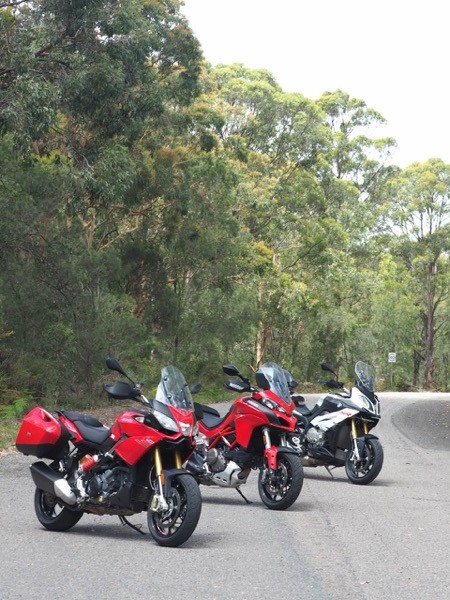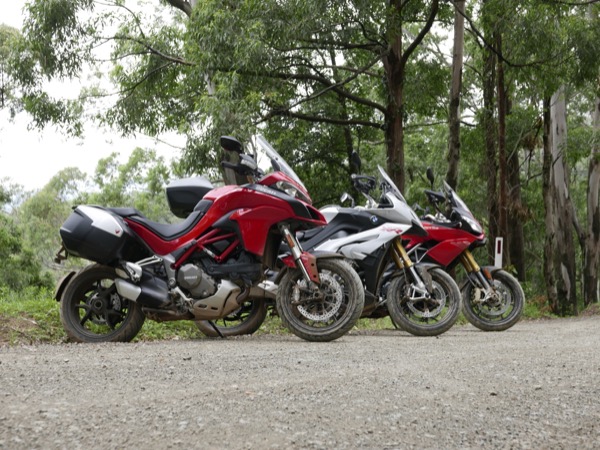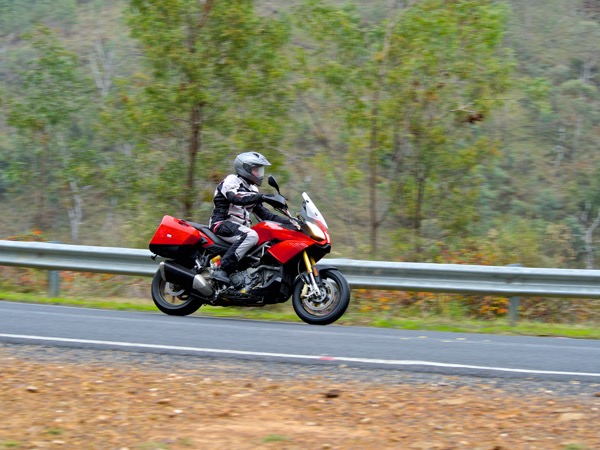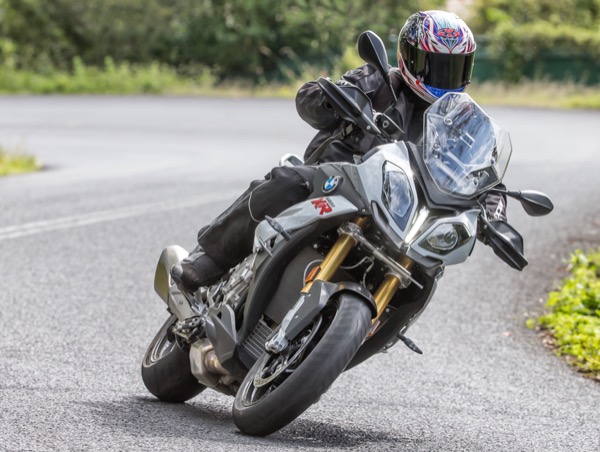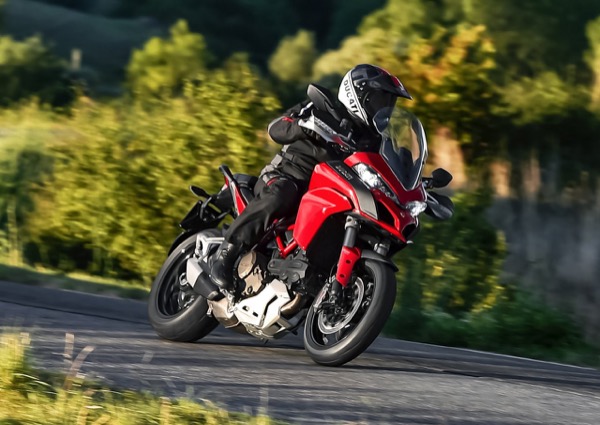THE FASTER you ride, the less time there is to react to changing conditions – so there was no time to react to the rut in the corner which appeared in front of me, a rut created by trucks braking into the bend, pushing the asphalt from where it was laid into a ridge beside the newly-created long, skinny pothole, which just happened to be on my line.
And I was going way to fast to avoid both the hole and the ridge – bumps which send most sportsbikes into suspension-bucking fits, so I relaxed, keep the power on and got ready for the tankslapping front end and pogoing tail… but it didn’t happen.
It didn’t happen to Pickett on the Caponord touring in front of me or Macarthur on the Ducati Multistrada behind me, and I was delighted with the way the BMW S 1000 XR seemed to simply glide over the ruts, the long travel suspension on the XR soaking up the punishment like it was made for it.
Well, maybe it was made for it – bad roads, that is. The new generation of road adventure bikes, as I call them, have been designed for road rather than track use, with riding positions which aren’t aggressive, with quality suspension units designed to cope with bad roads and with the facility to take luggage and go on tour.
Comfortable, fast, practical and fun, they may not be perfect but they might be perfect for you.
Not adventure bikes
With the introduction of the Ducati Multistrada Enduro, with its 19-inch front wheel and aluminium panels, none of the manufacturers represented here is trying to convince you any of these machines are genuine adventure bikes anymore – Aprilia, Ducati and BMW all have machines with laced wheels more suitable for off-road riding. So I’m calling these bikes road adventure bikes – machines which are fine on a good (even rough) dirt road, fun on smooth tar but outstanding on average to poor bitumen – what I seem to find myself riding on more and more these days.
The collection
We’ve had the Ducati Multistrada DVT in the Cycle Torque long-term shed for some time, so we decided for its last hurrah with Cycle Torque we’d compare it to a couple of bikes which riders in the market for such a machine might also consider, and settled on the Aprilia Caponord Touring and BMW S 1000 XR.
Aprilia’s Caponord Touring
Starting in alphabetical order, let’s have a look at the Aprilia first.
One of three Caponords in the range, it’s the middle model between the base Strada and adventure machine Rallye. As such it’s got lots of electronic wizardry, panniers standard and more than the other two is aimed at the touring market.
The power is provided by a 1200cc V-Twin producing 125 horsepower, which is more than enough for the class, although it’s quite a few down on the other two bikes here, however it only feels slow if you’re actually trying to out pace your mates.
The Caponord has been designed to be a comfortable ride across all roads and all seasons – so it has a protective fairing, but not one which blocks all the breeze in summer, it has a comfortable upright riding position which is fine in the city, and a tall enough screen that the wind blast at highway speeds doesn’t force you to hang on.
There’s cruise control for a relaxing freeway drone, and the button is already set into the switchgear for the optional heated handgrips – they should be standard.
The Caponord has ADD, aTC and ABS – Aprilia Dynamic Damping, Aprilia Traction Control and Anti-Lock Braking System.
ABS we’re all pretty familiar with. On this bike it can’t be switched off and was never intrusive. The aTC traction control system is designed to prevent wheelspin.
The most interesting of the acronyms is the ADD, Aprilia Dynamic Damping, which basically translates to semi-active electronic suspension.
Set to auto, the suspension automatically detects when you add weight via passenger or luggage and adjusts the suspension accordingly. It also constantly monitors the riding conditions and how the bike is being ridden – so suspension with start to stiffen up if you’re riding hard and it will also respond to changing road conditions.
It’s all fairly subtle, with nothing shocking ever bumping through the controls, and it all works pretty well, too – adding up to a nicer ride, but if you don’t like the feeling it imparts you can adjust everything manually via the dash, too.
The ride-by-wire controlled engine has various modes too, sport, rain and touring. Sport provides full power and the hardest hit to the throttle response, touring is where most people will spend most of their time, with its smooth throttle response yet full power availability, while rain mode is good for bad weather and heavy traffic.
BMW S 1000 XR
BMW has been building its GS model adventure bikes for decades and its four-cylinder sportsbikes for some years now, but neither range had a bike to compete with something like the Ducati Multistrada – less adventure, more performance.
So the Germans designed the S 1000 XR, a new model in the sporty S-range but with an upright riding position, touring capabilities and excellent performance characteristics, especially on public roads.
The heart of the machine is the 160hp (118kW) four-cylinder motor. It’s a wonderful, incredible powerplant – seamless power from just off idle to redline, and amazingly free of drive-line snatch or flat spots – I let the revs and speed drop to nearly 30km/h in top and simply rolled on the throttle and the bike didn’t hesitate, snatch or complain – it just pulled away cleanly and smoothly. Amazing.
Australian-delivered S 1000 XRs will come basically fully loaded with regards to suspension and electronic rider aids. So it gets ABS Pro, which works even as the bike is leaned, Automatic Stability Control (ASC), Dynamic Traction Control (DTC), which comes as part of the optional Pro riding modes. There’s also electronically controlled suspension, Dynamic ESA, which allows you to adjust the suspension – yes it’s a separate thing – plus riding modes and more. There are optional extras also but standard the bike comes highly equipped.
Understanding the ‘Aids’
In standard trim the XR comes with two riding modes, Rain and Road, but if you purchase the optional ‘Dynamic’ package for $1,375, you get DTC, Gear Shift Assist Pro (quick shifter), Riding Modes Pro, ABS Pro, Cruise Control and LED indicators, phew, you get access to two other riding modes, Dynamic and Dynamic Pro. As with pretty much every other rider aid system built, the further you go up the performance chain on the XR, the less intrusive the rider aids become.
I won’t go into each and every accessory because there is quite a few, from touring to performance and bling, but the other main optional package available is the Touring Package where you get Dynamic ESA, the attachments for a GPS, a luggage grid and case holders. You can of course decide not to buy any of this and go with the base model but if you want to retrofit any of these options at a later date it will cost you more than if you ordered it from new.
If you unleash all the power this has and go with the least amount of electronic intervention you will be heading towards the horizon at an alarming rate. This bike has so much stonk off the bottom it’s fun with a capital FAAAAARK!
Thank the stars it has the brakes and the suspension to match it. The suspension isn’t built for racetracks, it has decent travel designed for our crap roads, but it’s still on the soft side of sport. I found the suspension hard to fault really, whether it be when the bike is rolling and the electronics are doing their job or when you are adjusting the pre-load settings. It all just works as it should. Nothing is perfect of course but as an all-round package the XR is pretty right.
I loved the engine for it’s usable power, and it’s this sort of power that makes it more fun on the road than the RR’s powerplant. Of course they are very similar but while the RR keeps going after the XR has signed off it’s in territory most riders will never be on the road. The engine gets a ‘buzziness’ to it around 4000 rpm but it’s nothing that’s unpleasant.
The gearing is shorter than I expected too. I guess it’s part of the ‘real world’ aspect to the bike and to be honest I probably wouldn’t bother changing it. Top speed is around 250 kilometres, or so I’m told, so the short gearing no doubt plays a part in this too.
Ducati Multistrada DVT
Until the 2016 Multistrada Enduro, with its dirt-friendly spoked wheels and other off-road focussed design and components was announced in late 2015, Ducati wanted us all to believe the Multistrada DVT was an adventure bike, but it was soft-road at best.
With cast 17-inch wheels and lots of vulnerable plastic, the Multistrada wasn’t really taken seriously for off-road use, but in this company, it’s the best of the bunch. Its rider modes include enduro, which drops the power to 100 horses and sets up the ABS and traction control for off-road use, and the suspension works better than the other two in the gravel, too.
But bitumen is the natural terrain of this beast. The company’s racing heritage mean it can be punted around racetracks surprisingly fast, but cornering clearance becomes a real compromise, so again, not its natural terrain.
Another riding mode is urban, for taking on the city. Again there’s a drop in power output, but on the flipside the power is really, really tractable in urban mode and I’d recommend every Multistrada owner try it out – it was my preference for commuting. However, big 1200cc motorcycles are never at home in the urban jungle, so lets talk about where the Multistrada is at home – out of town, on the highway, on the backroads, taking on the twisties.
Australia has endless miles of sealed and unsealed roads which are the Multstrada seems to have been built for. It performs faultlessly on smooth bitumen, the wide ’bars giving heaps of leverage to throw the bike into turns, it leaps out of corners aggressively in sports mode as all the ponies are unleashed with a flick of the wrist.
For longer sections touring takes over, offering all the power with more relaxed throttle response. It’s also the mode to use on rougher roads, the smoother power making life easier over crappy roads, while the suspension all but eliminates the hassle of poorly maintained bitumen.
The new DVT variable valve timing technology has taken away the angry, aggressive nature of many previous Multistrada motors, a characteristic of extracting maximum horsepower – DVT means you can have 160 horses yet still have civility.
While some markets have found a flat spot in the torque curve of the DVT engine, we didn’t – smooth and seamless through the rev range, so I’m putting international issues down to different emission laws.
While the base-model Multistrada may not have the fancy suspension of the S-model, what it does have works really well, and I’d have to think long and hard before I’d commit and extra four grand to the up-spec version.
On tour
For this comparison BMW supplied the S 1000 XR with its optional top box, the Aprilia came with standard panniers and we’d already equipped the long term Multistrada with the touring pack – panniers, heated grips and centrestand.
All three bikes are excellent for eating the miles. The only bike with Touring in its name, the Caponord Touring, is simply the best tourer of the bunch – it’s the most comfortable (riding position and seat comfort), the panniers are the nicest to use, the engine is the most relaxing… this is a great bike to see the world on, and with its 24 litre fuel tank you can.
The Ducati’s panniers are compromised by the exhaust system exiting underneath the right hand side, so a cut-away design and heat shielding is built in, reducing capacity of the pannier, which is bummer if you have lots of gear to carry. In touring mode the bike is great to ride long distances, the big V-twin providing a nice throb as it lopes along easily.
BMW has a rich history of touring bikes, but the S 1000 XR was built by the sports devision. The short gearing and sometimes buzzy engine make it the least relaxing of these three to ride long distances, and the seat locks you into place and is thinly padded. We didn’t get to try out the optional panniers, but the top box was great to use, although it’s very pricey at over $1500. Despite those issues the XR is fine for long distance riding, but you’ll need more breaks, especially more than your mate on the Caponord…
Riding hard
Although the BMW and Ducati have the same claimed horsepower, I reckon German horses must be stronger than Italian ponies, for the S 1000 XR simply was faster than the the other two bikes. The Ducati was never far behind, but it didn’t leap out of turns as fast as the BMW and didn’t have to top-end rush, either.
Attacking the corners on the BMW and Ducati was more fun than on the Aprilia, but all three bikes are great fun in twisty countryside.
I’d ridden the Ducati quite a few miles before I got a chance to throw a leg over the BMW and I’ve been so impressed with the latest Multistrada I was surprised BMW managed to build the S 1000 XR so capable straight out of the box, but that’s exactly what they have done, and if I have to pick a sports winner, it’s the BMW.
In the gravel
With its enduro riding mode and great suspension, the Ducati is my preference when the surface turns to dirt.
Not the happy hunting ground of these bikes, many owners will consider dirt roads to be obstacles rather than fun routes, but that’s doing all these bikes a disservice – they are all not just capable on dirt roads, but fun.
They all have suspension well suited to gravel roads, their electronics means they aren’t the beasts they could be and wide ’bars, riding positions well suited to standing and tyres which actually work OK off road makes taking these bikes up the unsealed road to see the view from the top not just achievable but fun.
Although not adventure bikes, don’t discount the ability of these machines when the bitumen disappears.
Conclusion
With existing 2015 models now priced at $19,000 ride away, the Aprilia is certainly the bargain of the pack, and if your main priority is a touring bike, it’s hard to get past its touring comfort, range and value, but the other two certainly offer certain advantages.
The BMW is the sportiest of the group, it’s performance being simply amazing. Not only can it be ridden very hard in all sorts of conditions, it’s also a handy touring bike, too.
The Ducati though is the most versatile – simply the best of the bunch on gravel, very close to the BMW in outright performance and an excellent tourer with the touring pack fitted, the Multistrada has a lot going for it – so much so Macarthur bought it at the end of the test. He’d ridden them all and wanted the Ducati…

